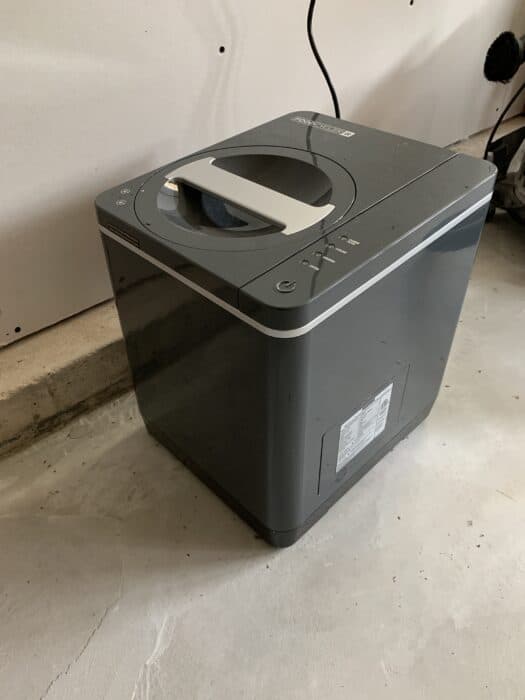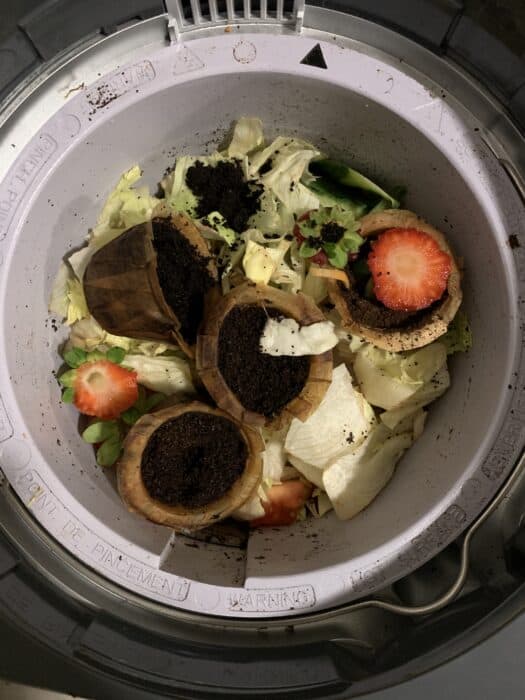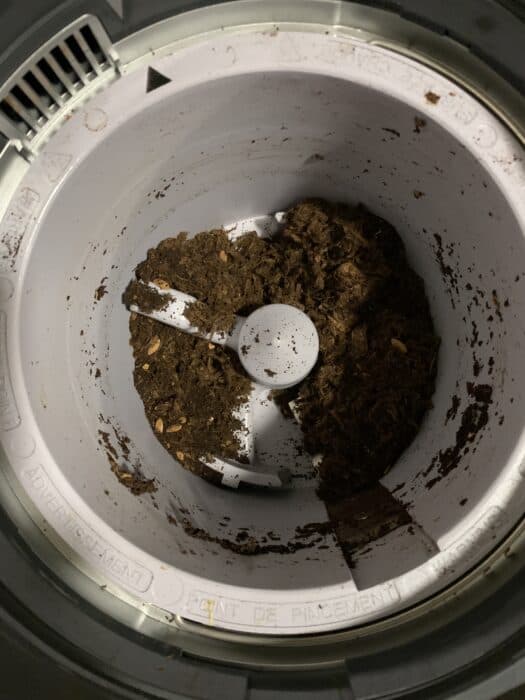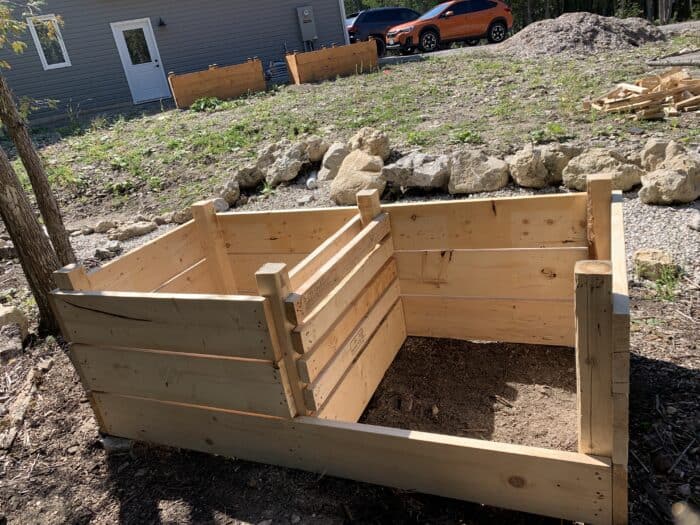We’ve had our FoodCycler™ for about 8 months now. In that time I’ve had a chance to experience almost all of the plant-based food waste we generate and how the machine processes it. I’ve also had a good chance to figure out the most practical ways I can think of to make use of the product the FoodCycler™ creates. In this article I’ll answer some common questions, and provide my overall opinion, including likes and dislikes, of electric composters in general.
What was my intention for getting a FoodCycler™ and has that intention been satisfied?
My main idea for getting an electronic food composter was to eliminate the need for a traditional outdoor compost pile. I was hesitant to have a traditional compost pile because our new home is in the woods, and we have bears! Well, we probably have bears; they’ve been spotted close to here but we haven’t seen one yet. I simply don’t want anything around to attract bears or any other opportunistic critters.
I also wanted to reduce and/or use our food waste somehow and an electronic composter appeared to be a viable solution. Even after reading some research that indicated that not only did it not create real compost, but if the product goes to landfills it creates even more trouble for the environment, I remained hopeful that I could figure something out.
In a nutshell, I’d say that no, my intention has not been satisfied – yet. I’ll explain why I’m still somewhat hopeful in a bit. First, let me cover some of the simple things you might want to know.
Where do I keep my FoodCycler™?
This is the first disappointment I discovered with the appliance. I had hoped to keep it in our pantry where I could close the door and let it run as needed. After my first few trial runs in the kitchen to see how it worked, I quickly discovered that a closed pantry is one of the worst places to keep it. Why? Because when it’s in operation, there is moisture released from the back of the appliance. We all know that moisture + closed rooms = mold. That’s bad news!
I then relegated the FoodCycler™ to the garage where it ran reliably … until the freezing weather came. I didn’t try running it in freezing temperatures only because if the moisture it creates freezes, either in the machine or in the filters, it would certainly be ruined somewhere inside at least. I haven’t brought it back inside because, while the smell isn’t offensive, it does still smell when it’s running through a cycle so I don’t really want that out in our living space.

This “where do I keep it” conundrum is one of the reasons why my intention with it has not yet been satisfied. I figured that I would run the FoodCycler™ all through the winter and stockpile the product. Then I’d turn it out into the compost pile in the spring. If I can’t run it in the winter, that idea is shot!
What goes into the FoodCycler™?
I use our FoodCycler for processing only raw plant-based food scraps and egg shells. I’ve read that you can put meat scraps in it but after some research, the resulting product is not suitable for use in a traditional compost or garden. Meat and animal products can create a product that, when returned to a garden or compost pile, can cause bad smells, attract pests and produce some rather disturbing mold.
In my first few runs I think I had some pieces of food that were left a little too large and they jammed up the grinder function. The large pieces were easily dislodged but I learned my lesson and now I chop my food waste into smaller pieces. For example, I’ll take the end of a head of lettuce or carrot ends and chop them into 4 quarters. I also shred large lettuce leaves before I put them in the FoodCycler bucket.
I have to admit that I do tend to fill it a little more than the line on the bucket indicates but to date that has not caused any trouble. That line is frustratingly low; often one day’s food prep can more than fill it.

How often do I run the FoodCycler™?
We have the FoodCycler™ FC-30 model which holds 2.5L. I’m not sure how they measure that volume because most days it doesn’t seem to hold very much (see note above). For our family of two, the FoodCycler runs an average of 2.5 times per week. During the summer it would run 3 – 4 times per week. If you’re a plant-based food loving family, you’ll need the large Eco-5 model. Maybe I should have gotten that one too. 🙂
What do I do with the product remaining at the end of the FoodCycler™ cycle?
After running the Great Compost Experiment, I determined that the product at the end of the cycle wasn’t in fact compost at all; it is dehydrated and ground-up food. I still have to have a compost pile to finish the composting process. Now, I put the FoodCycler product into my compost pile with yard waste, some browns and occasionally I also add fresh kitchen food waste to bulk up the pile. Occasionally I’ll add in some Compost Accelerator and I’m hoping I can stop that once my compost starts doing its job well.

Through the experiment, and experience of using the FoodCycler™ product in a traditional compost pile, I’ve discovered – well, I’m pretty sure at least – that I have to adjust the ratio of browns to greens and water in my compost pile. This is to account for the much smaller particle sizes and lack of moisture in the FoodCycler product, in order to create an active compost pile.
Have I had any trouble with my FoodCycler™?
During the trial period I did have trouble with the Foodcycler™ unit. During one cycle it started to sound a little clunky and louder than usual. After a few more cycles it was screeching and sounded more like it was trying to grind bolts. After a bit of troubleshooting via email, the unit was promptly and easily replaced.
I must say, the support for the machine is phenomenal. My contact gave clear directions and took the time to understand the issue. He didn’t waste too much time trying to figure out what was happening before telling me how to have my machine replaced. I know that almost anything manufactured these days can run into trouble. What matters most to me is how easily the trouble can be resolved. I must say FoodCycler™/Vitamix™ excels in customer service. Yes, I’m aware that I’ve only had this one interaction with them, and maybe I got lucky. I’m calling it Good Customer Service anyway.
What do I like most about this Electric Composter?
- It makes easy work of managing food scraps.
- It creates a “clean” food waste product, so it’s easy to work with.
- I like the idea that the product would be less attractive to compost pests. Luckily that hasn’t been tested yet!
What do I like least about my FoodCycler™ FC-30?
- It doesn’t hold much food waste. I suppose that could be a good thing, but I don’t love the idea of having to run it so often.
- I can’t figure out where to keep it. Maybe that’s something more about me than the machine but it’s still frustrating.
- It doesn’t actually make compost. I still have to manage the food waste to make it into something usable if I want to keep it out of the landfill.
- If you don’t have some kind of composting process, it creates something that’s even harder to dispose of than raw food waste.
Does the Electric Composter really solve anything?
That’s such a big question! There’s a lot I haven’t figured out yet about electric composting appliances. They seem like such a good idea and yet, like so many “green” initiatives, they fall flat at best, create more problems at worst. In fact, I’m not sure they solve anything at all.
The more I use our FoodCycler™ and try to figure out the advantages, the more it feels like a complicated jigsaw puzzle where some important finishing pieces are still missing. I’ve been thinking that I’m just as well off to just chop my food waste up into smaller bits and put them directly into my compost. If it feeds a mouse or squirrel or racoon along the way – well, so be it. It’s still the bears that I’m really concerned about!

I think the only way electric composting can be of real value on a large scale is if the cities/townships/towns the devices are in have a means of collecting the product in volume and then “we” would have to find a way to make use of it. I can see some kind of opportunity in the creation of large composting facilities or maybe biodigesters that can generate electricity. I do know that these solutions are already either in place or being attempted across the country.
Oh! And collection in a rural area like ours, will generate its own issues – what with the bears and other food motivated, opportunistic critters around. It’s clear that I don’t have the answers to the large scale food waste issues. Back to the home electric composter …
Even though I don’t have it all figured out yet, I like the machine well enough to use it when I’m able to. I’ll simply turn the product into my traditional compost system. I imagine, in time I’ll just stop using it – I’m not a fan of adding extra, unnecessary steps to doing things. I remain hopeful though that the lessons learned from these machines will lead us on to truly viable, net gain, solutions.
P.S. Yes, I have included Amazon Affiliate links to the FoodCycler™ in this post. If you’re still inclined to give it a shot I’d be grateful if you used my links. If you do, please contact me to let me know how you’ll be making use of your electric composter. I’m SO curious!
Recent Posts
7 Totally Selfish Reasons to Choose Native Plants for Your Gardens
Grab a cup (or glass) of your favorite beverage, and let's delve into what I’ve learned so far about why it's incredibly important and wildly selfish to embrace landscaping with locally native...
Exploring the differences, benefits and drawbacks of Broadcast Sowing and Frost Seeding for Native plants.
